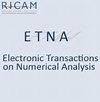A posteriori stopping criteria for space-time domain decomposition for the heat equation in mixed formulations
IF 0.8
4区 数学
Q3 MATHEMATICS, APPLIED
引用次数: 10
Abstract
We propose and analyse a posteriori estimates for global-in-time, nonoverlapping domain decomposition methods for heterogeneous and anisotropic porous media diffusion problems. We consider mixed formulations, with a lowest-order Raviart–Thomas–Nedelec discretization, often used for such problems. Optimized Robin transmission conditions are employed on the space-time interface between subdomains, and different time grids are used to adapt to different time scales in the subdomains. Our estimators allow to distinguish the spatial discretization, the temporal discretization, and the domain decomposition error components. We design an adaptive space-time domain decomposition algorithm, wherein the iterations are stopped when the domain decomposition error does not affect significantly the global error. Thus, a guaranteed bound on the overall error is obtained on each iteration of the space-time domain decomposition algorithm, and simultaneously important savings in terms of the number of domain decomposition iterations can be achieved. Numerical results for two-dimensional problems with strong heterogeneities and local time stepping are presented to illustrate the performance of our adaptive domain decomposition algorithm.混合公式中热方程空时域分解的后验停止准则
我们提出并分析了非均匀和各向异性多孔介质扩散问题的全局时间非重叠域分解方法的后验估计。我们考虑通常用于此类问题的具有最低阶Raviart–Thomas–Nedelec离散化的混合公式。子域之间的时空接口采用了优化的Robin传输条件,并使用不同的时间网格来适应子域中的不同时间尺度。我们的估计器允许区分空间离散化、时间离散化和域分解误差分量。我们设计了一种自适应时空域分解算法,其中当域分解误差对全局误差没有显著影响时,停止迭代。因此,在时空域分解算法的每次迭代中都获得了总体误差的保证界,并且同时可以实现在域分解迭代次数方面的重要节省。给出了具有强非均匀性和局部时间步长的二维问题的数值结果,以说明我们的自适应域分解算法的性能。
本文章由计算机程序翻译,如有差异,请以英文原文为准。
求助全文
约1分钟内获得全文
求助全文
来源期刊
CiteScore
2.10
自引率
7.70%
发文量
36
审稿时长
6 months
期刊介绍:
Electronic Transactions on Numerical Analysis (ETNA) is an electronic journal for the publication of significant new developments in numerical analysis and scientific computing. Papers of the highest quality that deal with the analysis of algorithms for the solution of continuous models and numerical linear algebra are appropriate for ETNA, as are papers of similar quality that discuss implementation and performance of such algorithms. New algorithms for current or new computer architectures are appropriate provided that they are numerically sound. However, the focus of the publication should be on the algorithm rather than on the architecture. The journal is published by the Kent State University Library in conjunction with the Institute of Computational Mathematics at Kent State University, and in cooperation with the Johann Radon Institute for Computational and Applied Mathematics of the Austrian Academy of Sciences (RICAM).

 求助内容:
求助内容: 应助结果提醒方式:
应助结果提醒方式:


